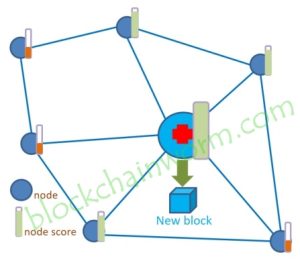Page Contents :
Empower the Masses With Democratic Consensus Mechanisms
Different types of consensus mechanisms were introduced earlier, including Proof of Work (PoW) ![]() , Proof of Stake (PoS)
, Proof of Stake (PoS) ![]() , and Delegated Proof of Stake (DPoS)
, and Delegated Proof of Stake (DPoS) ![]() .
.
We will conclude the consensus topic by introducing two mechanisms, Proof of Importance (POI) and Proof of Participation (POP).
Blockchain developers believe that it is neither fair nor secure to be able to verify transactions and add blocks to the blockchain by purchasing expensive hardware or investing large amounts of money.
Therefore, a new fairer mechanism was developed to evenly distribute decision rights (greater say) and rewards, and to better decentralization.

POI was first introduced in 2014 by a developer named Makoto Takemiya as a consensus mechanism for the New Economic Movement (NEM) ![]() blockchain project.
blockchain project.
It was designed to reward network participants based on their contributions to the network, rather than on their computing power, as in the case of PoW.
POP is a relatively new consensus mechanism that combines elements of POI and PoS, rewarding network participants based on their participation in the network.
It was co-created by Roberto Capodieci and Barton Johnston and used in the Blockchain Zoo blockchain platform.
How The POI Consensus Mechanism Works
POI is used on the NEM blockchain platform to secure transactions and maintain the integrity of its blockchain network.
POI determines the importance of nodes based on the contributions of network participants to the network.
Unlike PoW, which relies on computational power, and PoS, which relies on the amount of cryptocurrency held.
That is, all nodes in the network have the same importance or influence.
- the number of cryptocurrencies held by the node, such as the XEM cryptocurrency used on the NEM platform,
- the number of transactions processed by the node,
- the length of time the node has been active on the network,
- and the node’s reputation score.
These factors are combined to calculate the Importance Score of each node.
Nodes with higher importance scores are given more decision rights in the consensus process.
And are more likely to be selected to create new blocks and validate transactions.
Overview of POP Consensus Mechanism Operation
POP combines elements of POI and PoS to create a hybrid consensus mechanism to create a more inclusive and participatory consensus mechanism.
The score of POP nodes is called the Participation Score.
When a node validates a transaction and adds a new block to the blockchain, that node receives a ticket from other nodes.
The participation score is calculated from the resulting tickets, each of which has a different value.
- the level of participation of its node and how often it goes offline,
- the amount of cryptocurrency staked by the node,
- the number of transactions accurately verified by nodes,
- and The speed at which it performs its work.
The better a node performs its work, the higher the value of its ticket.
The ticket value will eventually be added to each new block, and this value can no longer be tampered with.
The POP mechanism is to calculate the total participation score for all tickets of a node.
And the higher the total participation score, the more likely the node will be selected to validate new transactions.
How POI Determines The Importance Score
- Staked Tokens – The more tokens a node has staked, the higher its importance score.
- Number of Transactions – The more transactions a node processes, the higher its importance score.
- Reputation Score – assessed based on the node’s overall contribution to the network, including the number of transactions accurately verified.
The importance score is calculated using a formula that combines the three mentioned factors above.
The formula is as follows:
Importance Score = Function( Stake, Transaction, Reputation)
The Participation Score and Verification Of POP
To participate in the POP consensus process, users must stake their tokens.
The more tokens a user stakes, the higher their participation score will be.
Users with higher participation scores have more decision rights in the consensus process.
And are more likely to be selected to validate transactions.
In short, POP consensus is the selection of a node to validate a transaction based on the node’s score.
The more staked tokens a node has, and the more transactions it validates, the higher its score will be.
The more likely that node will be selected and perform a simple computational task to validate the transactions.
Comparison Of POI and POP
In this section, we will discuss the main differences between POI and POP consensus mechanisms, as well as their advantages and disadvantages.

– It encourages network participation and contributions rather than computing power or cryptocurrency holdings.
– It is more energy efficient than PoW as it does not require a lot of computing power.
– It is resistant to 51% attacks because nodes with higher importance scores have a greater say in the consensus process.
– All nodes are encouraged to participate in verifying transactions through the quality of their work, which helps improve the overall security and stability of the network.
– It combines the advantages of POI and PoS to provide a more fair and balanced mechanism.
– It requires a higher level of technical expertise to implement compared to PoW or PoS.
– It may be vulnerable to manipulation by nodes holding large amounts of currency.
– May incentivize nodes to favor having more staked tokens rather than actively participating.
– May require more complex computational approaches to reach consensus.
Future Developments
In summary, the consensus mechanisms of POI and POP are must-understand concepts for anyone interested in the field of blockchain technology.
POI focuses on determining the importance of nodes based on factors such as transaction history and network activity.
The POI blockchain network must have the ability to track and calculate the value of nodes, such as the number of stake tokens and transactions.
The underlying challenge is the need to incentivize users to actively participate in transactions, as this is the main factor that determines the importance of a node.
To incentivize users’ participation, the network must provide sufficient rewards.
POP combines elements of POI and PoS to reward nodes that participate in verified transactions.
However, it must calculate the stake and participation scores of nodes more accurately and address the potential challenges in terms of centralization issues.
As blockchain technology continues to evolve, we can expect to see the further development and application of these consensus mechanisms.
The research and development of POI and POP aim to improve the scalability, security, and efficiency of blockchain networks.
Overall, the technical details of POI and POP are fascinating and impactful.
Their continued research and development will play a key role in shaping the future of blockchain technology.




